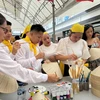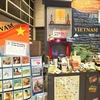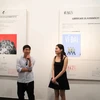Hanoi (VNA) - Three artisans grew up in three different rural areas in the Red River Delta with different backgrounds and roots, but all share a passion for ancient values that their predecessors left for Vietnamese traditional pottery.
Artist restores the oldest pottery line in Vietnam
Nguyen Dang Vong - a son of Dau area, Thuan Thanh district, Bac Ninh province, has devoted dozens of years to restoring and preserving the traditional occupation of his ancestors. He is considered by his community as the man of the Dau ceramic.
Artist Nguyen Dang Vong began making pottery products during 1976-1977. At that time, historical scientists such as Tran Quoc Vuong and Duong Trung Quoc visited Luy Lau area (Bac Ninh province) to excavate ceramic products. They discovered the pottery kiln, the 2,300-year-old Luy Lau citadel and also the ancient Luy Lau pottery village.
The historians then shared with Vong that if he could restore the ancient pottery culture of Luy Lau, it would be very good, so he was determined to pursue and has been attached to the work for more than 40 years.
 According to artisan Vong, Luy Lau ceramic products will produce different colors in line with different light angles (Photo courtesy of Nguyen Dang Vong)
According to artisan Vong, Luy Lau ceramic products will produce different colors in line with different light angles (Photo courtesy of Nguyen Dang Vong)
After graduating from the Faculty of Fine Arts, the Ha Bac College of Culture and Arts in 1980, Vong said his passion for pottery was in his blood, making him travel everywhere to learn about the Luy Lau - Dau region.
He wandered around many museums to learn about ancient ceramics. Sometimes, he stayed in many famous pottery villages of the northern region such as Bat Trang, Phu Lang, Chu Dau and then went to Tho Ha in Vinh Phuc province to learn about pottery and how to make it.
 Artisan Nguyen Dang Vong has devoted almost his entire life to Luy Lau pottery. (Photo: Nguyen Nam/Vietnam+)
Artisan Nguyen Dang Vong has devoted almost his entire life to Luy Lau pottery. (Photo: Nguyen Nam/Vietnam+) Quintessence of Vietnamese ceramic
Luy Lau pottery is known as aristocratic as it is associated with the name of an ancient Vietnamese citadel -- the Luy Lau - during the northern Chinese domination period in the old land called Dau in the 2nd century.
The celebrated artisan Nguyen Dang Vong has put all his heart and talent into discovering and restoring the ceramic glaze of the Luy Lau pottery. He has successfully found that the glaze is made of extracts from assorted ash, mulberry tree wood in the local Dau-Keo area.
The main pottery clay is also taken from the land of the Dau area, with a little bit of gravel from the forest and scallop shells of the sea then decorated with artistic drawings.
According to artisan Vong, through many trials with both failures and certain successes, up to now, the products can reach the completion level of 80-90 per cent similar to the predecessors' original Luy Lau ceramics.
“Such glaze is really unique, unlike any other in Vietnam and in the world. From nearly 40 years of my research and through excavations and seminars, historian Quoc also said that Luy Lau pottery has become a historical brand since 2,000 years ago," Vong said.
 At a conference on Luy Lau pottery of Vietnam Association of Historical Sciences in July 2007, scientists confirm that Luy Lau pottery is the oldest pottery line. (Photo: Nguyen Nam/Vietnamplus)
At a conference on Luy Lau pottery of Vietnam Association of Historical Sciences in July 2007, scientists confirm that Luy Lau pottery is the oldest pottery line. (Photo: Nguyen Nam/Vietnamplus) The Luy Lau ceramic products were often crafted with fancy glaze, elegant and warm olive green colour by the most skilled artisans exclusively for the royals and aristocrats. The products were also used as materials for building temples, palaces and decorative artworks for royalty.
Although from the era when heating technology was still very rudimentary and after thousands of years of social and historical changes, this ceramic line is considered to be the epitome of technique and art.
Artisan Vong established the Luy Lau Ceramic Cooperative in 2006, which recruited many young people to study the Luy Lau traditional pottery. From there, new generations will follow the pottery occupation making it develop into a brand name.
The co-operative produces about 10,000 items of 10 product categories every year.
Prominent among his works is a 2.2-tonne ceramic vase, which was on display during the celebrations of the Ha Noi city millennium anniversary in 2010.
Luy Lau ceramics have appeared in major domestic, regional and international events including the APEC and WTO economic forums and meetings./.




















